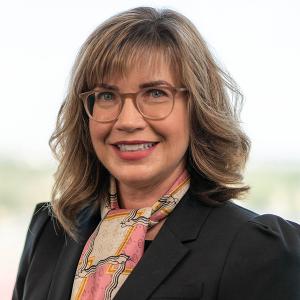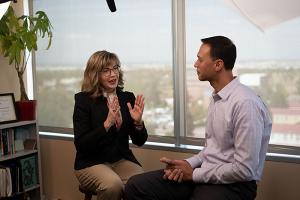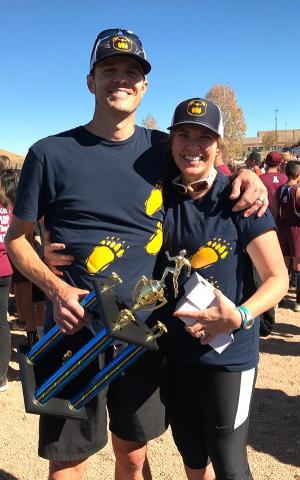Five questions for Anne Libby
Anne Libby has helped hundreds of faculty members advance their careers since she came to the University of Colorado in 2000. As an expert on mentored research and leadership training, she has developed numerous programs that provide people with the skills to be successful in their fields.
Libby, a professor and vice chair for academic affairs in the School of Medicine’s Department of Emergency Medicine, wasn’t always involved in health care. She wanted to be an economist “because it felt powerful that you could reshape the entire wealth distribution of a country with taxes. I was going to make the world a better place and do public finance.”
Her transition into health care began with her dissertation research.
“It was an exciting field at the beginning of the Bill Clinton era of health care reform, and the whole country was going to need economists to try to figure out how to do this health thing. And that’s how I became involved with health care research.”
As a postdoc at the University of California, Berkeley, she worked for researchers studying how Colorado was paying for Medicaid services. “They kept sending me to Colorado to do data collection. I drove all over the state and visited community mental health centers and interviewed people.”
That experience cemented her work in the health field and spurred her to decide Colorado would be a good place to call home.
In her role as vice chair for academic affairs, Libby helps department faculty progress in rank by focusing on career goals. That includes engaging in strategic career planning, writing dossiers, pitching their value and contributions, and generally mentoring and coaching them. This work, in part, earned Libby the CU Faculty Council’s 2018 Elizabeth D. Gee Memorial Lectureship award, which recognizes efforts to advance women in academia.
She pushes others, and herself, to always move forward, away from comfort zones.
“I think one of the sayings that always has stuck with me, and I turn around and say it to other people, came from my dad. He used to say, ‘If it was easy, everybody would do it.’ It’s part of my upbringing to always want to push myself, not rest on my laurels and figure out how to do more, do better, do different.“
1. You aid faculty through mentored research and leadership training. What does that entail?
I teach clinicians how to do research and build research careers, and I also train people to become good leaders, which is essential in this business. Most clinicians know how to take care of patients, and so even if they have had a research-focused additional training period, they don’t have formal training in research like they would if they were a Ph.D. They are learning on the job.
A lot of it is just trying to help them catch up, and so I use mentoring and training to bootstrap people’s skills, one by one. Some of it is basic study design and analysis. Some of the training includes grant writing, because in our business, we need external funding to do research, and there is a whole set of skills about writing grants and the scientific writing that goes with that. There’s another enormous body of skills that I teach that is about what happens after you get a grant. Essentially, once you get the grant, you are running a small – or sometimes large – business. You’ll have a budget to manage, maybe $50,000 or $2 million. Most of these people don’t have the business experience to hire, fire, manage, purchase and really steward their resources, whether money or people. All those skills need to be acquired for people to be successful and it has zero to do with their science.
The two hallmarks of leadership are self-knowledge and communication. You have to understand what your frame of reference is; what you are bringing to the table, including how you filter information to make judgements. Those are the two guiding principles for effective leadership skills. It is so critical in this business because there is so much self-determination in academic medicine. You need to think about how you communicate and engage with others, individually or in groups.
Being effective as an academic and as a leader relies on communication in writing, too, and that is why our programs do so much writing, whether it be scientific, training or personal branding. So much of engagement with others is in the written word. Think of all the writing you do in your life. Especially in a technical field, you can really distinguish yourself if you can write well. People’s research gets funded when educated nonexperts can read the proposal and get excited about the concept.
2. You have initiated numerous faculty development programs. What are some of those programs and what are the objectives?
I’ve started or run many programs over the years, and most are school-wide or campus-wide. Many of my programs are attached to the Colorado Clinical and Translational Sciences Institute (CCTSI), which includes the Anschutz and Denver campuses and Colorado State University. The programs are quite generalized, and the skill sets can be used by everyone. It started with an intensive mentoring research training program called the Clinical Faculty Scholars Program, which helps early career faculty in clinical or outcomes research establish successful careers. We are in the 16th year and many of our scholars are now leaders on campus.
While doing that, I came to see that there are these other sets of skills that are actually at least as important as getting the science right or getting the grant. That spawned Colorado Mentoring Training (CO-Mentor), which is a structured mentoring program that trains people to be mentors. We could see early on that some of the scholars’ struggles were because some of the mentors weren’t quite getting it or the mentors were fine, but the mentees were dropping the ball on communicating their goals and needs. A former mentee and now colleague, Greg Austin, and I just started the 10th CO-Mentor program where we’ve trained 500 people.
It is clear that being a good mentor means being a good leader of yourself and communicating with others, and so it became obvious that we needed leadership development, too. I started a leadership training program called LITeS, Leadership for Innovative Team Science, which was for senior scientists or people who manage researchers. Today, under Judith Albino, LITeS trains mid-career faculty and intact teams. Of course, you really can’t just train the people who are in formal leadership, you also need to train people from the beginning of their careers. A colleague and mentor of mine, Judy Regensteiner, and I run a women’s leadership program for early career women faculty. Women tend to face implicit and explicit bias. As a woman, if you make a mistake, generally you will pay a higher penalty. Although everybody needs leadership training, women need more and sooner, and we’ve trained hundreds of early career women in leadership skills. The entrepreneurial spirit of academic medicine makes a lot of the self-knowledge, communication, and what you would call leadership skills absolutely essential to success.
I also run the Career Cornerstones program with a group of friends who have similar jobs in faculty development, a general early career faculty development program. There are six departments that get together and do good, old-fashioned career development: networking, time management and strategic career development.
3. You were honored with the Elizabeth D. Gee Memorial Lectureship in 2018 for your efforts to advance women in academia, interdisciplinary scholarly contributions and distinguished teaching. You’ve noted the early career development program you founded. In what other ways have you worked to help women?
There is a major pipeline problem with women in academics. There is parity at the training level and even at the early step of a career, for instance instructor or assistant professor. However, with each step of seniority, you lose significant numbers of women. Across the nation, by the time you look at associate professor, the numbers are down to 30 percent women, and for full professor, you find only 18 percent women. The tenured professor rank has fewer women. Those numbers are above average in Colorado, and we have some notable wins for women in senior rank and in leadership.
There are multiple factors that cause this, including a well-established pay gap. For the same work, women make less money. Women tend to disproportionately bear the burden of family needs. And although I think it is changing, some women feel it is hard to advance because of their gender.
In my department, my chair Rich Zane supported our establishing a structured system into place to help everybody advance in rank. The system doesn’t rely on people saying they are ready to advance. Case studies have found that men will constantly ask for opportunities, but women may not. For instance, women won’t apply for a job unless they meet all the criteria; men will apply when they meet, say, five of the 10 criteria.
We wanted to take advancement away from the personal impetus and lay the tracks for everybody to progress. Just since I’ve been in emergency medicine, which is not quite five years, we went from me being the only woman professor to having eight female full professor emergency physicians. Now our department has the most female professors in any Department of Emergency Medicine in the country. These policies helped men, too. The same number of men were promoted as women in this time period. We share these innovations in the hope that similar systems are implemented in every department.
I’m also senior faculty at the Center for Women’s Health Research. Women have consistently been left out of research as subjects except for the past 25 years. Most of the drugs that we have available to us and most of the procedures that we would have as a patient were tested on males only. That is an extreme disadvantage for the health and well-being of women. We are committed to developing the research that will help women catch up with the evidence that is available for men. I am involved in helping the faculty development for the men and women who pursue that research. We need to recruit them to do these kinds of studies and then make sure they have the skills to be successful and stay in the field. That’s how we will grow the field.
4. Do you have new projects or programs in the pipeline?
I’ve got a new project that incorporates what we’ve learned about how to make people successful through this training. We’ve taught hundreds and hundreds of faculty at CU and nationally, and yet there are so many more people that we could reach, here and globally. We have funding to build a Coursera course – a massive open online course – on research management and leadership training. The goal is to build the course and test whether this modality is effective at helping researchers gain these skills using an online platform. We’re filming the course now, and it will be launched worldwide March 1, 2020. It’s the first of anything like it, and we’re excited about it.
5. Your coaching doesn’t stop when you leave the university. How are you helping others in the community?
One of the things I do outside of work is that my husband and I started a cross-country team at the middle school that our kids attended, Good Shepherd Catholic School. My husband is a great coach. I always wanted to coach, but I don’t know any sports rules. But I can run a little. He needed a partner to help, so we became coaches Dan and Anne. We started it when our daughter was in middle school and she and our son both ran. They are off in college now, but we still coach. This is our 10th season, and every year between 40 and 50 kids from grades six through eight come out and run multiple times a week. Last year our boys team won the state championship. It’s special because boys and girls run the same course, and everyone races. You can see enormous personal growth in the participants. Middle school is a critical time in teen development, especially for girls, to learn their own power and what they can achieve with effort and drive. It doesn’t matter whether you are a star athlete. We’ve had kids who literally could only run one block when they started, but at the end, they are running nine-minute miles. It’s great to see what people can do.




